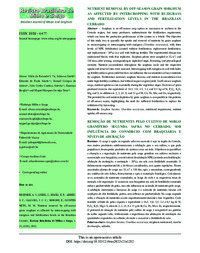Nutrient removal by off-season grain sorghum as affected by intercropping with ruzigrass and fertilization levels in the Brazilian Cerrado.
Nutrient removal by off-season grain sorghum as affected by intercropping with ruzigrass and fertilization levels in the Brazilian Cerrado.
Autoria: RESENDE, A. V. de; GIEHL, J.; SIMÃO, E. de P.; ABREU, S. C.; GALVÃO, J. C. C.; BORGHI, E.; GONTIJO NETO, M. M.
Resumo: Sorghum is an off-season crop option in succession to soybean in the Cerrado region, but many producers underestimate the fertilization requirement, which can harm the productive performance of the system as a whole. The objective of this study was to quantify the uptake and removal of nutrients by grain sorghum in monocropping or intercropping with ruzigrass (Urochloa ruziziensis), with three levels of NPK fertilization (control without fertilization; replacement fertilization; and replacement + 30%) in a soil with built-up fertility. The experimental design was randomized blocks with four replicates. Sorghum plants were sampled at 33, 67, and 130 days after sowing, corresponding to eight-leaf stage, flowering, and physiological maturity. Nutrient accumulation throughout the sorghum cycle and the respective uptake and removal rates were assessed. Intercropping with ruzigrass in soil with builtup fertility reduces grain yield but does not influence the accumulation of most nutrients by sorghum. Fertilization increases sorghum biomass and nutrient accumulation even under high-fertility conditions, but without impact on grain yield. In off-season sorghum crops, nutrient uptake occurs essentially during the vegetative stages. Each ton of grain produced removes the equivalent of 14.5, 5.0, 3.5, 1.1, and 0.5 kg of N, P2 O5, K2 O, Mg, and S, in addition to 2, 2, 25, 9, and 11 g of B, Cu, Fe, Mn, and Zn, respectively. The potential for soil nutrient depletion by grain sorghum is comparable to the patterns of off-season maize, highlighting the need for sufficient fertilization to replace the withdrawal by harvesting.
Ano de publicação: 2022
Tipo de publicação: Artigo de periódico
Unidade: Embrapa Milho e Sorgo
Palavras-chave: Absorção de Nutrientes, Brachiaria, Consorciação de Cultura, Nutriente, Sorgo, Urochloa ruziziensis
Observações
1 - Por padrão são exibidas publicações dos últimos 20 anos. Para encontrar publicações mais antigas, configure o filtro ano de publicação, colocando o ano a partir do qual você deseja encontrar publicações. O filtro está na coluna da esquerda na busca acima.
2 - Para ler algumas publicações da Embrapa (apenas as que estão em formato ePub), é necessário ter, no celular ou computador, um desses softwares gratuitos. Sistemas Android: Google Play Livros; IOS: iBooks; Windows e Linux: software Calibre.
Acesse outras publicações
Acesse a Base de Dados da Pesquisa Agropecuária (BDPA) para consultar o acervo completo das bibliotecas da Embrapa.

